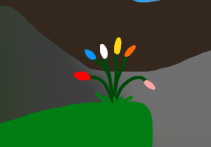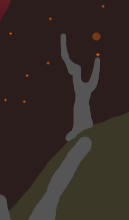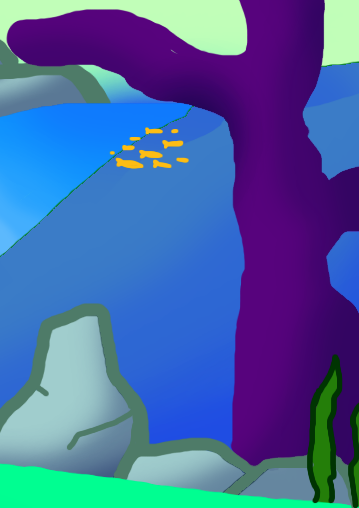 Xass - Plural: Xass. World: Xavier. Range: (?)
Xass - Plural: Xass. World: Xavier. Range: (?)
Edibility: Meh... Flavor Profile: Bitter, sweet. Taste: Earthy, very watered down purple grape. Height: ~1-2"
Xass is the most basic and abundant plant life on Xavier. Plants consist of a small, fleshy leaf with a slight divot in the center (sort of like a thumbprint) and a thin, basic root. Leaves grow short, near translucent velvet that make them feel soft to the touch. Their tough flesh and low nutritional value make them a generally poor food source for non-specialized consumers. If eaten, they taste like an earthy, very watered down purple grape. Their insides are filled with a thick jelly akin to aloe vera that stores water and excess sugars. This allows them to grow in arid environments, though they're more commonly found in areas with more pleasant temperatures. Coloration can range from purple to pink in varying saturations depending on plant breed and soil type. Each leaf reaches one to two inches when full grown. Plants reproduce by growing tiny velvet pods - identical in appearance to the regular velvet to the naked eye - on their surface in optimal times of the year. Sources such as wind and fauna detach these pods, spreading the foliage to new ground. Their name simply comes from Xavier + grass
Tubule - Plural: Tubules. World: Xavier. Range: (?)
Edibility: Topically medicinal. Flavor Profile: Bitter. Taste: "This might be dirt". Height: ~3-4"
Xass has many variations that have evolved to better survive different stressors. Tubules are taller, standing roughly three to four inches at their full height. They're the same basic shape as Xass, being a leaf with a divot in the center, though Tubules have a rounded tip and curl tighter at the base. This forms a small 'straw' where a drop of water will often become trapped. Their leaves are waxy which gives them a slight sheen. Some types of Tubules will grow slight, semi-translucent velvet on their surfaces, but not all. These are debatably even harder to eat than base Xass considering their tougher skin. To add insult to injury, they've developed to grow on very nutrient-poor soil, taking up the space that no other plant wants. Their insides are filled with a very thick jelly-like substance that will not run if the plant is cut open. This goop is good for soothing irritated wounds such as cuts and scrapes, but has little other use. It tastes like nothing aside from the slightest hint of 'this might be dirt'. Coloration is typically green, though purple and yellow variants are not unheard of. Leaves often sport whiteish variegation in the form of stripes
Rockplant - Plural: Rockplants. World: Xavier. Range: (?)
Edibility: Edible. Flavor Profile: Sweet. Taste: Sugar water. Height: ~1" or less
Rockplants are very small, being only an inch tall if that. They're fleshy little bumps that grow together in clusters, often resembling a scattering of gravel. They use this camouflage and their closeness to the ground to avoid being eaten by most fauna. They have a high sugar content, which can make them more nutritionally valuable. If eaten, they taste like sugar water (which isn't really surprising, considering). Their coloration is highly variable, becoming almost anything in order to best blend in with their environment. Rockplants prefer to grow in rocky soil or in the shade of large stone formations such as a pile of boulders
Snagger - Plural: Snaggers. World: Xavier. Range: (?)
Edibility: No. Flavor Profile: Bitter. Taste: Sharp & burning. Height: ~1-2"
Snaggers are a variation of Xass that replace the central divot with a single, large thorn for defense. The thorn and upper side of the leaf are waxy while the underside is only fleshy. The waxy areas will grow short, semi-translucent velvet that's a touch pricklier than the usual stuff. While considered a bother in gardens, Snaggers often grow alongside other Xass types, contributing to keeping the whole of them alive. Their insides are filled with a jelly akin in texture to cold syrup. This liquid is acidic to the point of shocking unaware consumers and comes along with a sharp, burning taste. Snaggers grow one to two inches in height. While they often seek out their own species to grow alongside, they seem to crop up just about anywhere (unless it's too cold). They're colored brightly, often with spots or stripes, to further warn others to stay away. Their undersides tend to be pale from lack of exposure to the light
Snap Xass - Plural: Snap Xass. World: Xavier. Range: (?)
Edibility: Meh... Flavor Profile: Umami. Taste: Slightly yeasty, mushroom-like earthiness. Height: ~3" (unbent)
Snap Xass is a taller type, growing to around three inches in full, though they're commonly bent to a shorter height. Their leaves have a small divot at the base while the rest of the plant is thick and fleshy, often compared to a finger for disturbance value. The tip of the plant has a small protrusion like a root that will seek earth to embed into. Once there, it will curl up, anchoring the plant in an arch. If disturbed, the protrusion will come loose and, if all goes well, make the little leaf slap the would-be consumer right in the nose. This is usually enough to keep more skittish predators at bay. Once the Xass has snapped, it will remain upright for the rest of its life. As such, these things grow in large patches for safety in numbers. 'Snapped' plants will produce more seed pods than they otherwise would in an attempt to further protect themselves. This can lead to dramatic overpopulation, so it's not strange to see what looks like a huge, mutant wad of Snap Xass. They grow in temperate areas, often forests or fields. Their coloration varies from purple, pink, green, yellow, to white, but typically remains pale in an attempt to not draw attention. They often feature pale stripes for further camouflage. The overall plant is very crispy with a snap akin to celery. While they have a high water content, it isn't loose in the form of jelly like other Xass types. They taste slightly yeasty with an earthiness bearing resemblance to mushrooms

 []
[]
 Giant Tubule - Plural: Giant Tubules. World: Xavier. Range: (?)
Giant Tubule - Plural: Giant Tubules. World: Xavier. Range: (?)
 Ash Pod/Ash Pod Tree - Plural: Ash Pods/Ash Pod Trees. World: Susie. Range: The Valley (central)
Ash Pod/Ash Pod Tree - Plural: Ash Pods/Ash Pod Trees. World: Susie. Range: The Valley (central) Babyfood Pod, Babyfood Bush - Plural: Babyfood Pods, Babyfood Bushes World: Susie. Range: The Valley (non-desert)
Babyfood Pod, Babyfood Bush - Plural: Babyfood Pods, Babyfood Bushes World: Susie. Range: The Valley (non-desert) [Blue Fiona] Plural: Blue Fionas World: Susie. Range: The Valley (temperate)
[Blue Fiona] Plural: Blue Fionas World: Susie. Range: The Valley (temperate)
 [Willow wand]
Plural: Willow wands World: Susie. Range: The Valley (temperate)
[Willow wand]
Plural: Willow wands World: Susie. Range: The Valley (temperate)
 [Dropleaf] Plural: Dropleaves. World: Susie. Range: The Valley (lush)
[Dropleaf] Plural: Dropleaves. World: Susie. Range: The Valley (lush) Each plant grows roughly 2-5 leaves depending on height, so it's important to have a good wad of them if you're planning on using them in a lot of meals! Once a year, dropleaves will produce a single, small flower. These have many, small, pointed petals that range from white to pale purple in hue. Dropleaves taste best before they bloom, so it's best to harvest before plants bolt. Each flower will produce about a dozen seeds, which may not seem like much if one doesn't account for how many plants grow together
Each plant grows roughly 2-5 leaves depending on height, so it's important to have a good wad of them if you're planning on using them in a lot of meals! Once a year, dropleaves will produce a single, small flower. These have many, small, pointed petals that range from white to pale purple in hue. Dropleaves taste best before they bloom, so it's best to harvest before plants bolt. Each flower will produce about a dozen seeds, which may not seem like much if one doesn't account for how many plants grow together [Mikii] Plural: (Same) World: Susie. Range: The Valley (dense forest)
[Mikii] Plural: (Same) World: Susie. Range: The Valley (dense forest) [Kaas Paddles] Plural: (Same) World: Susie. Range: The Valley (open fields)
[Kaas Paddles] Plural: (Same) World: Susie. Range: The Valley (open fields) [Colorbulb] Plural: Colorbulbs World: Nature realm. Range: ?
[Colorbulb] Plural: Colorbulbs World: Nature realm. Range: ? [Very Dead Tree] Plural: Very Dead Trees World: Flame realm. Range: ?
[Very Dead Tree] Plural: Very Dead Trees World: Flame realm. Range: ? [Poolplant] Plural: Poolplants World: Dew realm. Range: ?
[Poolplant] Plural: Poolplants World: Dew realm. Range: ? [Coral tree] Plural: Coral trees. World: Dew realm. Range: ?
[Coral tree] Plural: Coral trees. World: Dew realm. Range: ? [Wrong Holiday Tree] Plural: Wrong Holiday Trees. World: Luminous realm. Range: ?
[Wrong Holiday Tree] Plural: Wrong Holiday Trees. World: Luminous realm. Range: ?